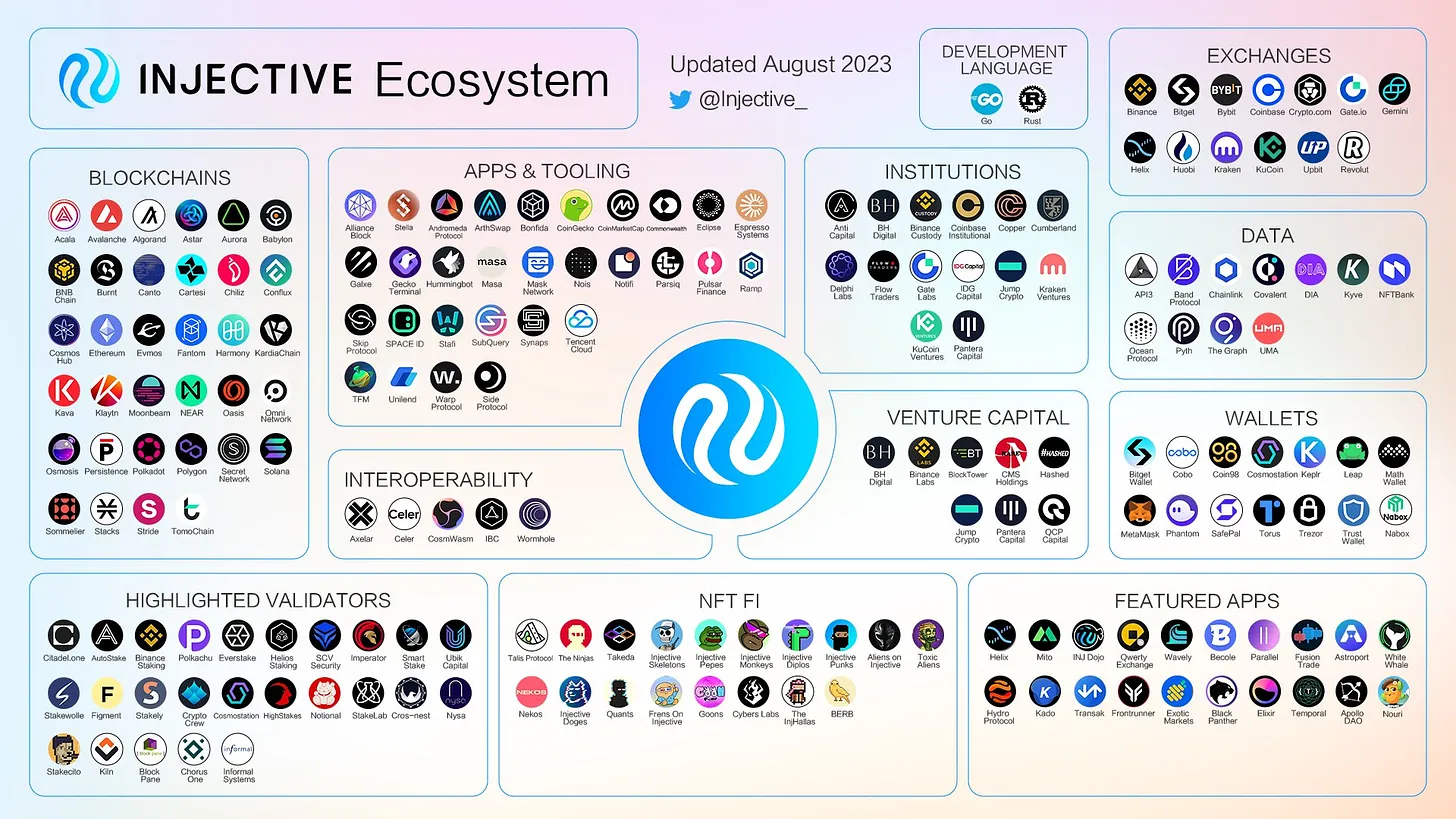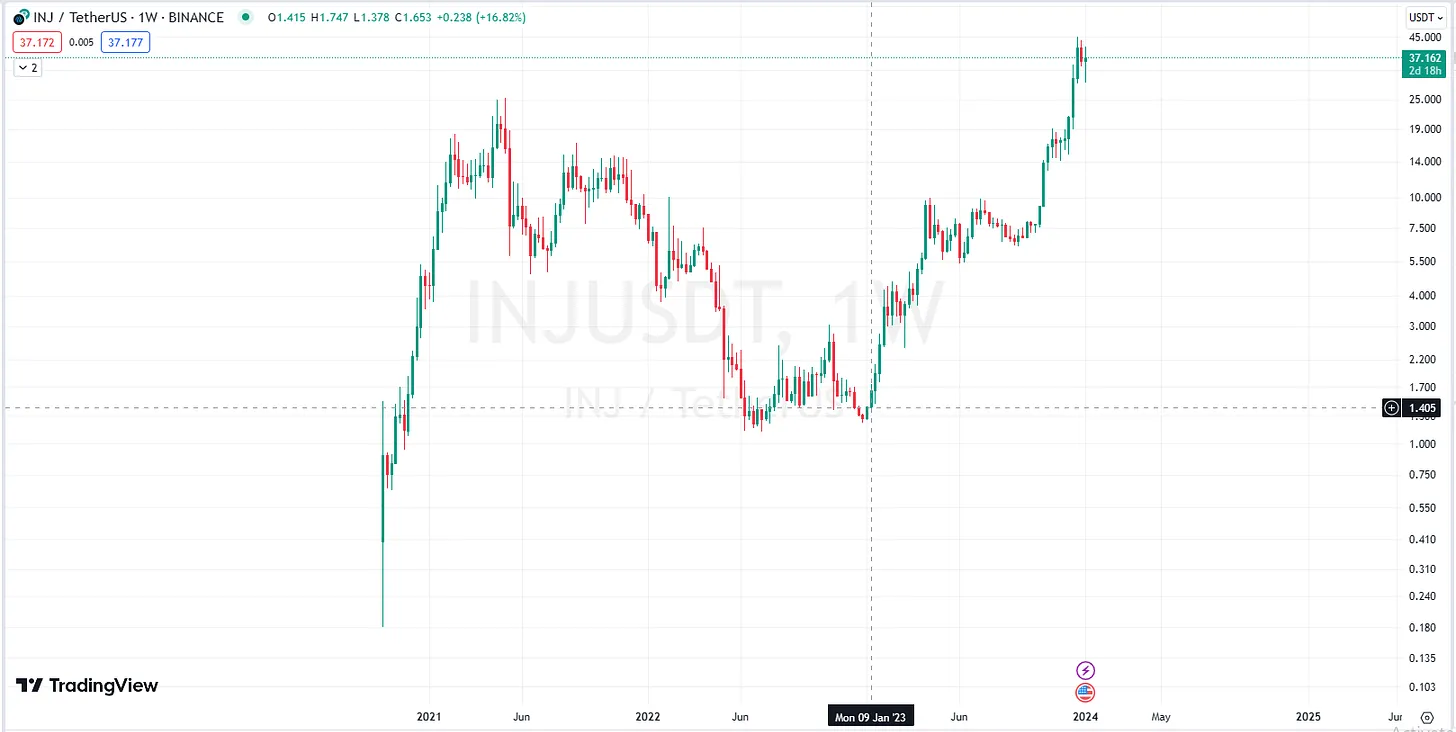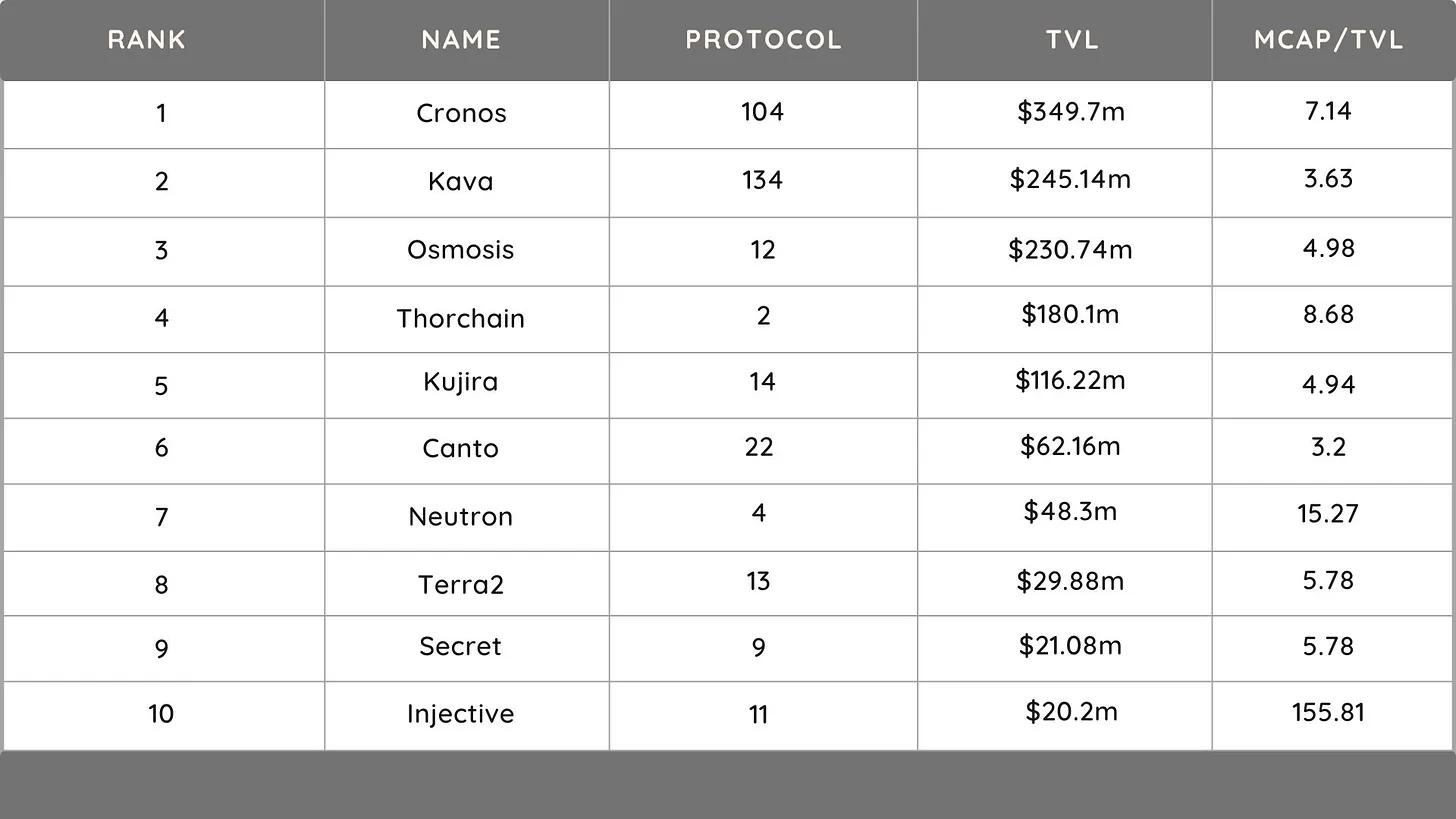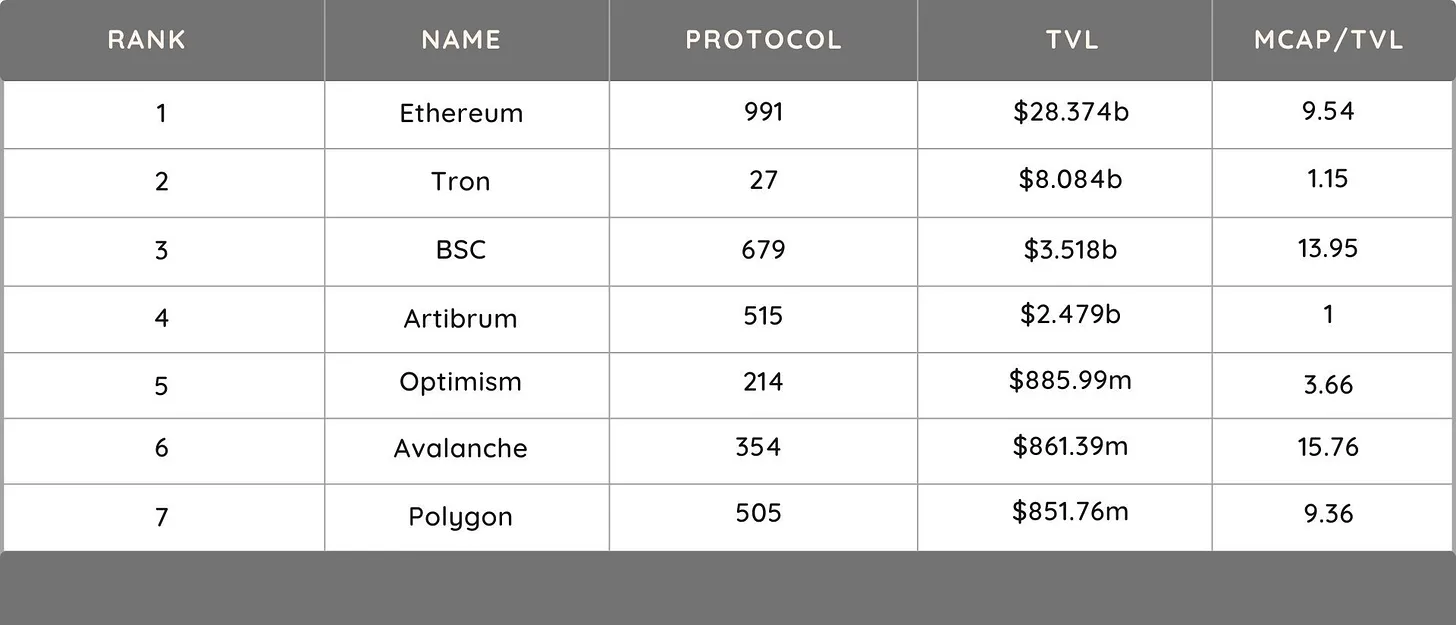Original author: THOR HARTVIGSEN
Original compilation: Deep Chao TechFlow
INJ hit a low of $1.4 in January 2023 and peaked at an all-time high of $45, with its market capitalization ballooning from $110 million to a staggering $4.5 billion. Such a huge increase has attracted a lot of attention in the market, and this article will cover an overview of the Injective ecosystem, INJ token economics, comparative analysis with other projects, airdrop strategies, and Volan upgrades.
introduce

Injective Protocol is an interoperable L1 blockchain optimized for DeFi applications. It comes with out-of-the-box features such as a fully decentralized order book, making it possible to develop applications such as exchanges and prediction markets. Built using the Cosmos SDK, Injective leverages Tendermint consensus for instant transaction finalization and facilitates fast cross-chain transactions with major networks such as Ethereum and IBC-enabled chains
Injective Hub is a platform and gateway for interacting with Injective, providing wallet, governance, staking and INJ burning auction functions. The native token INJ is used for governance, staking and dApp value acquisition. The initial supply is 100 million tokens, and a deflation mechanism is implemented through burning auctions.
$INJ token growth has seen significant growth in 2023, rising by more than 3000%. Part of this growth can be attributed to growth in TVL and subscriber numbers, but its certainly also related to the increased coverage surrounding INJ.
Trade on Injective
Injective’s trading infrastructure allows for the creation and trading of a variety of spot and derivatives markets. It supports on-chain price-limited order book management, transaction execution, order matching, transaction settlement, and transaction incentive distribution, providing a comprehensive environment for decentralized transactions. Developers can build dApps using CosmWasm, the smart contract platform for the Cosmos ecosystem, enabling seamless migration of smart contracts across chains.
Ecosystem overview
The Injective ecosystem is characterized by its DeFi-focused dApps, primarily focused on spot derivatives trading and asset management. This overview highlights several noteworthy dApps in the ecosystem:
Helix
Helix is the most famous protocol in the Injective ecosystem and the largest Perpetual DEX (Perp DEX). It facilitates trading of cross-chain crypto assets and perpetual markets, providing market-leading rebates. Helix operates with zero gas fees, low taker fees, and competitive Maker fee rebates, ensuring a cost-effective trading experience.
It has a total transaction volume of over $16 billion and a TVL of $10 million, making it the largest dApp in the ecosystem. For context, the dYdX chain is now part of the Cosmos ecosystem with a TVL of $349 million and cumulative transaction volume of over $1 trillion (total transaction volume of dYdX V3+V4). While direct comparisons to the largest Perp DEXs may seem ambitious, Helix still has a long way to go to compete.
Black Panther
Black Panther is a decentralized asset management protocol designed to deliver superior returns through smart vaults. These vaults utilize active trading strategies such as grid trading, providing a unique source of alpha that differentiates Black Panther Finance from typical automatically compounding yield protocols. The protocol has a TVL of $3.6 million as of January 5, 2024, using strategies such as grid trading, trend following, and real returns. Vaults have generated APYs of up to 100-600%.
Dojoswap
Inspired by Uniswap, Dojoswap is an automated market maker (AMM) protocol on the Injective blockchain. It facilitates the decentralized on-chain exchange of various assets within the ecosystem.
Astroport
Astroport is a decentralized, permissionless, open source DEX. The protocol is governed by a community of token holders through Astral Assembly, Astroport’s DAO, and supports permissionless asset listings, multiple pool types and a strong incentive structure. It features programmable liquidity, a new Rust codebase, Oracle integration and easy dApp integration, supports various liquidity pool types, and provides a data-rich user interface. Astroport is live on Terra, Sei, Injective and Neutron.
Talis
Talis is similar to Blur on Ethereum, providing an NFT marketplace, launchpad, and artist tools. It facilitates the buying, selling, and trading of NFTs within the Injective ecosystem. $TALIS tokens are confirmed to be issued, and to be eligible one must interact with the platform, such as buying or selling NFTs.
INJ Token Economics
INJ Token Overview
INJ tokens will launch with an initial supply of 100 million coins
Inflation rate: The token’s inflation rate is set at 7% initially and is planned to decrease to 2% over time to control supply growth
governance
Token Utility: INJ serves as the governance token of the Injective chain, enabling token holders to participate in key ecosystem decisions
DAO participation: INJ holders can propose new market listings and participate in other governance decisions, contributing to the decentralized management of the protocol
Community-driven governance: The Injective Labs team gives up voting rights to ensure that governance rights remain in the hands of the community, promoting a democratic and decentralized governance structure
deflation mechanism
Buyback and Burn: INJ has implemented a buyback and burn mechanism where 60% of the fees collected by the ecosystem are used to purchase INJ tokens which are then burned
Supply Reduction: This deflationary process is designed to reduce the total supply of INJ tokens over time, potentially increasing scarcity and value
To date, a total of 5.8 million $INJ tokens worth $241 million have been burned through auctions
INJ Destruction 2.0 Upgrade
Enhanced Token Burn: The INJ Burn 2.0 upgrade allows all dApps built on Injective to participate in the INJ Burn Auction with no limit on the amount they can burn
Economic Impact: This upgrade aims to strengthen the on-chain economy and further unify the interests of various stakeholders by capturing value from all dApps in the Injective ecosystem
The INJ token economy is structured to balance the initial token supply with mechanisms to incentivize development, reward users, and maintain a deflationary supply to support token value. The governance model ensures that the community plays an important role in the direction of the protocol, while the burning mechanism is designed to create a sustainable economic model for the Injective ecosystem.
INJ Price Performance
INJ hit a low of $1.4 in January 2023 and peaked at an all-time high of $45, with its market capitalization ballooning from $110 million to a staggering $4.5 billion.

comparative analysis
Despite the impressive performance in terms of price action and market capitalization growth, the TVL metric has not grown significantly enough to justify such a significant increase in valuation. Let’s compare INJ valuation to the popular ecosystem within Cosmos using DefiLlama’s simple Mcap/TVL metric.

Injectives Mcap/TVL ratio is 155, which is higher than almost any other ecosystem.
For a quick comparison with other major ecosystems outside of Cosmos, see the table below:

Compare Injective to Kujira and Osmosis
Osmosis DEX and Kujira are two different and popular app chains/Defi applications running within the Cosmos ecosystem, each with their own unique features and offerings. Osmosis is an AMM-enabled spot DEX that allows the creation of liquidity pools and facilitates IBC-enabled token trading. Currently, the exchange has 92 coins and 329 trading pairs.
Kujira is a Cosmos L1 blockchain platform that prioritizes community-selected projects. It operates on a semi-permissioned basis, requiring governance approval to initiate contracts, ensuring the quality and sustainability of the network. Kujira features an on-chain scheduler that reduces reliance on bots, thereby reducing wasteful transactions and increasing protocol efficiency. The platform supports native token generation, simplifying smart contract development as each token becomes a native Cosmos token.
Airdrop strategy
The surge in price and popularity has attracted a lot of attention, especially related to token airdrops, and several projects have confirmed airdrops to INJ holders. With a strong $150 million ecosystem fund, the project will attract users and generate traction through airdrops. Here are some potential airdrops, and how to get them.
wallet
Get Keplr Wallet-https://www.keplr.app/
Send INJ from CEX to your Keplr wallet or convert assets to INJ on Osmosis or Astroport
Helix
Exchange or trade on the Helix app.
Talis
Stake $INJ through the Talis protocol,For more details click here。
Black Panther
Stake $INJ with a Black Panther validator orDeposit into one of its vaults。
Volan mainnet upgrade
The Injective Volan mainnet upgrade, known as Proposal 314, is a planned update to the Injective blockchain network. This upgrade is important because it will temporarily stop the blockchain at a specific block height and then restart with a new version of the software, 1.12.0. The main improvements in this upgrade include:
Real World Assets (RWA) module, introducing a new way to create and manage assets representing real-world financial products (such as tokenized fiat currencies or credit products) in a compliant manner
Improved cross-chain capabilities via IBC Hooks and packet forwarding middleware, enabling more complex transactions across different blockchain networks
Reducing on-chain inflation parameters is expected to make INJ tokens more scarce and potentially more valuable over time
Improved scalability through new enterprise APIs designed to reduce latency, especially for institutional players
Added a unique oracle design that will allow for the integration of off-chain price feeds, enabling the launch of unique assets and markets on Injective
Expanded functionality for burning bank tokens generated on Injective and integrated EIP 712 V2 for better Ethereum wallet integration and developer experience
All in all, there’s a lot of interesting stuff happening in the Injective ecosystem. While recent price action can be attributed more to narrative than improving fundamentals, it’s clear that the ecosystem has several catalysts this year, including overall ecosystem growth, technology upgrades, and the protocol’s airdrop marketing campaign.










